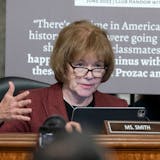As Minnesota and the rest of the country look ahead to off-year political races and midterm elections, the recent presidential contest's aftermath is still revealing new data about who voted – and who didn't.
Minnesota saw noticeable lags in participation among young voters and minorities compared with other demographic groups, despite being known for its high voter turnout and leading the nation again in 2016.
Nationally, there were stark declines in turnout among black voters, according to the Voting in America survey from the U.S. Census Bureau, particularly in important battleground states where thin margins helped propel President Donald Trump's historic electoral victory in November.
Black voter turnout nationwide declined about 7 percentage points compared with the 2012 survey, while Hispanic voting held relatively steady between elections, despite immigration being a hot topic during the campaign.
In Minnesota, white voters had about a 71 percent turnout, while the voting rates were 66 percent for blacks, 52 percent for Asians and 37 percent for Hispanics.
Gaps between the youngest and oldest voters in Minnesota were pronounced. Turnout among those 18 to 24 reached only about 55 percent, compared with about 73 percent of those 45 or older.
In short, the survey shows older, white voters outpaced younger and more diverse populations at the ballot box, mirroring trends on the national level.
Because of high margins of error for the state-level results from this survey, those findings for Minnesota could be slightly higher or lower than what was reported. Unfortunately, this survey is one of the few public data sources to shed light on voter demographics.


